Why Your Basement Needs a Water Channel
A squishy basement floor is a frustrating sign of water intrusion. A basement water channel is an interior drainage system built along the inside perimeter of your basement to catch water and move it out.
Here’s what a basement water channel does:
- Collects water: Gathers seepage from walls and the floor.
- Relieves pressure: Reduces hydrostatic pressure pushing against your foundation.
- Prevents flooding: Keeps your basement floor dry.
- Protects your home: Guards against structural damage and mold.
This guide explains how these systems work to achieve a dry basement.
I’m Darin Garvey from Basement Waterproofing Scientists. With over 30 years of experience in leak detection and customized basement water channel solutions, our team ensures dry, safe basements, allowing you to reclaim your space.
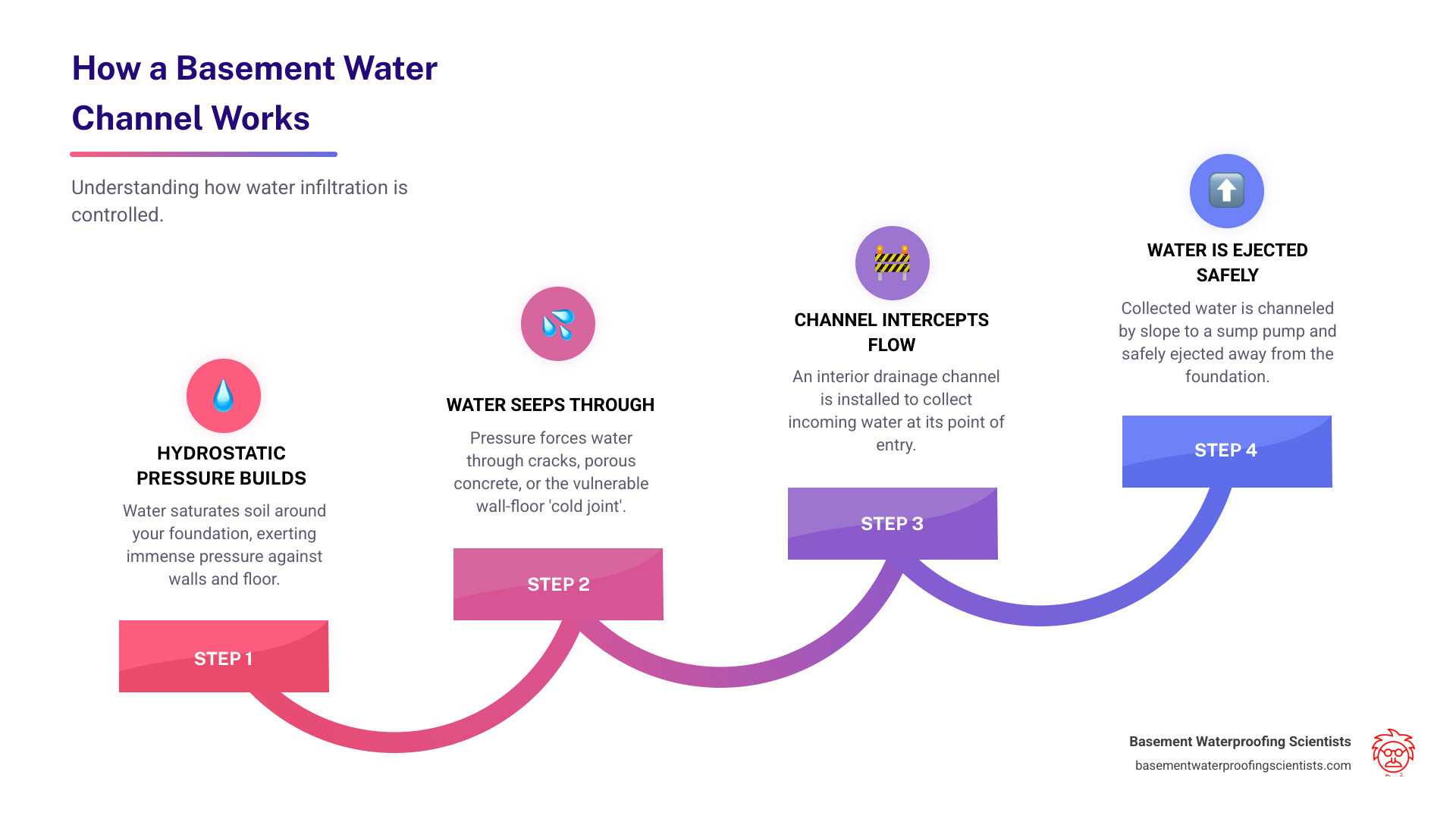
Understanding the Science Behind a Dry Basement
Water often enters basements due to hydrostatic pressure, the force exerted by water accumulating in the soil around your foundation. After rain or snowmelt, saturated soil can exert thousands of pounds of pressure per square foot on your foundation, forcing water through cracks, porous concrete, and the vulnerable joint where the floor meets the walls.
Many people try to block water with sealants or paints, but these are temporary fixes. They often fail because they fight against the immense force of hydrostatic pressure.
A basement water channel works with physics, not against it. By creating a path of least resistance, the channel collects water as it enters and directs it safely away. This relieves the pressure, changing a damp, musty space into a dry, usable area.
A properly installed interior drainage system is a long-term solution, lasting 20+ years with minimal maintenance.
What is a basement drainage channel and why is it important?
A basement water channel is an interior waterproofing system installed along the perimeter of your basement. It acts as a collection system, catching water from walls or the floor before it can cause damage.
Its importance is fourfold: it prevents flooding, protects your foundation from long-term moisture damage, improves air quality by controlling moisture and preventing mold, and creates usable living or storage space.
How an Interior Drainage System Works
An interior drainage system works in a few simple steps:
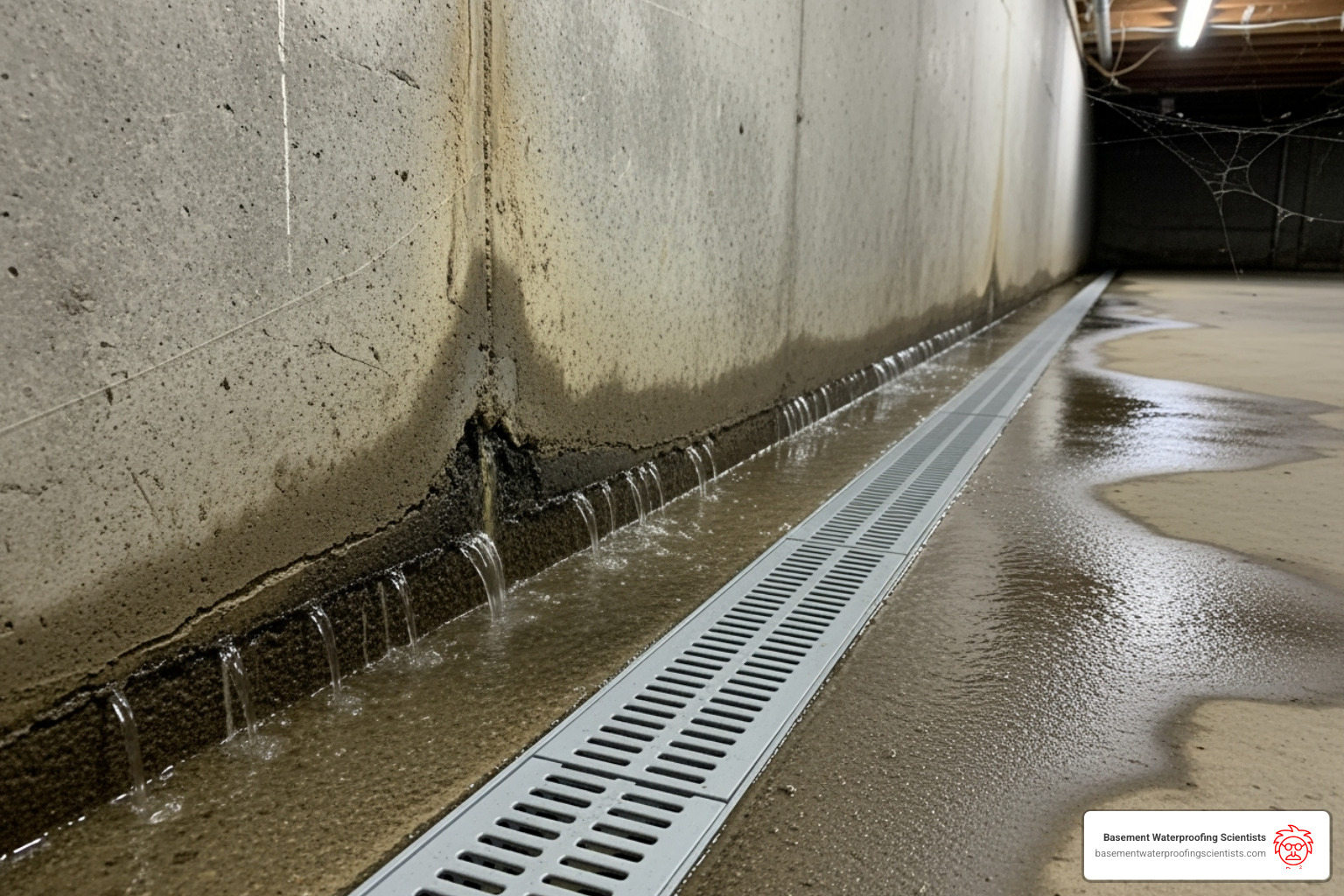
Intercepting water at the cove joint: The system is placed at the floor-wall joint, where most leaks occur. It creates a capillary break, interrupting water’s path and catching it as it enters.
Channeling water via slope: The channel is installed with a slight slope, using gravity to ensure water flows steadily toward a collection point.
Directing to a sump pump: Water flows into a sump pump basin, the central hub of the system.
Ejecting water away from the foundation: The sump pump automatically activates to pump the water out through a discharge line, moving it safely away from your home.
Choosing the Right Drainage System for Your Home
Choosing the right basement water channel requires a custom solution based on several factors. Key factors include your home’s foundation type (poured concrete, block, or monolithic slab), the severity of the water intrusion, and your budget. While interior systems are often more affordable than exterior solutions, ranging from $4,000 to $8,000, this is not a DIY project. Professional installation is crucial for a permanent solution.
Here’s how different interior drainage methods compare:
| System Type | Installation Disruption | Typical Installation Time | Lifespan | Maintenance Accessibility |
|---|---|---|---|---|
| Sub-Floor Perimeter Channel | Moderate (jackhammering) | 1-2 days | 20+ years | Good (via clean-outs) |
| Baseboard / Above-Floor Channel | Low (no jackhammering) | 1 day | 20+ years | Excellent (visible) |
| Thin-Slab Low-Profile Channel | Low-Moderate | 1-2 days | 20+ years | Good (via clean-outs) |
| Cross-Floor Interceptor | Moderate (jackhammering) | 1 day | 20+ years | Good (via clean-outs) |
| Surface Trench Drain at Entries | Low-Moderate | 1 day | 20+ years | Excellent (visible) |
Types of Interior Basement Drainage Channels
We offer several types of basement water channel systems, each designed for specific situations to ensure a permanently dry basement.
Our sub-floor perimeter channel is a below-slab system ideal for most poured concrete or block foundations. It’s installed in a narrow trench around the perimeter to capture water from walls and under the slab before it reaches the floor.
Baseboard systems are an excellent alternative when jackhammering isn’t feasible (e.g., with radiant floor heating). These channels install on top of the floor against the wall, collecting seepage with minimal disruption.
Thin-slab low-profile channels are designed for homes with thin concrete floors, often found in historic properties. This system sits in front of the footing, avoiding the need for a new floor pour.
Cross-floor interceptor channels address water coming up through cracks in the middle of the floor. They run across the floor to intercept and drain this water.
Surface trench drains are grated channels installed across entry points like walk-out doors or garage entries to capture surface water before it can flow inside.
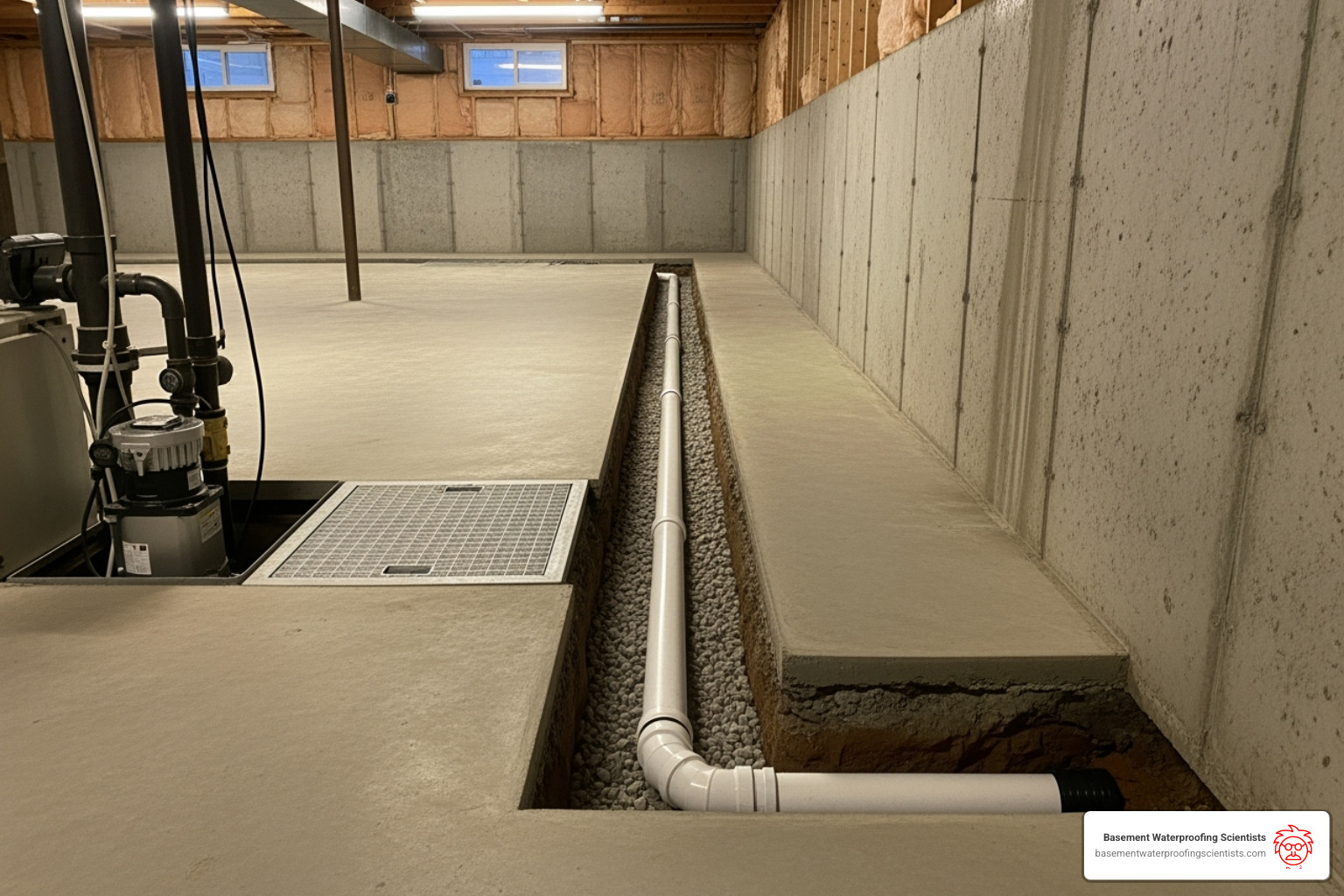
Our team at Basement Waterproofing Scientists will select and professionally install the right system for your home.
Key components of a basement water channel system
An effective basement water channel system relies on several key components working together:
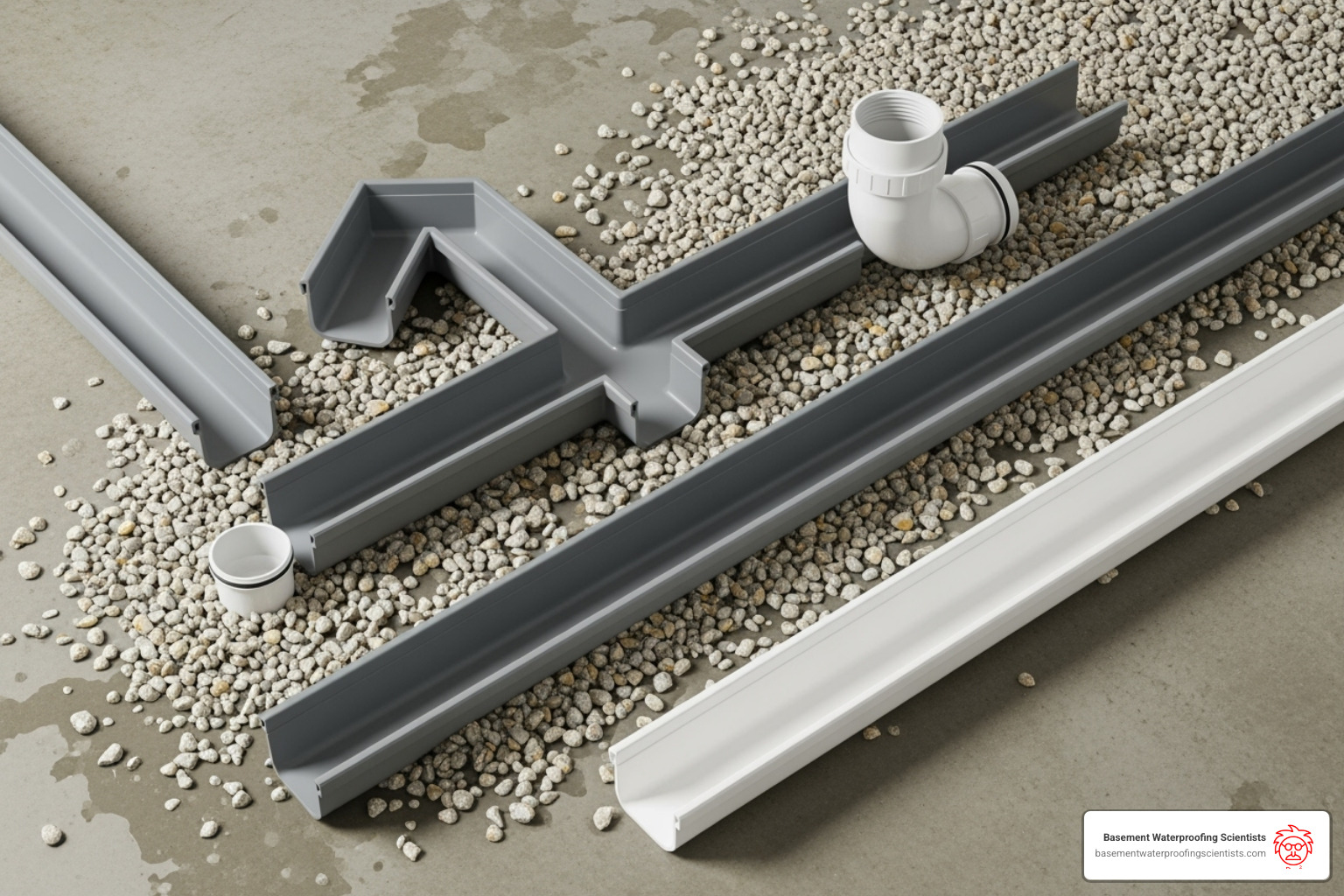
The HDPE or PVC channel body is the corrosion-proof, high-capacity backbone of the system.
The wall flange creates a small gap at the wall to catch seepage before it reaches the floor.
Perforations and inlet holes allow water to enter the channel from the floor-wall joint and from under the slab.
Clean-out ports provide easy access for inspection and maintenance, ensuring long-term performance.
The sump pump basin is a robust container that houses the sump pump.
Drainage stone (pea gravel) filters debris, provides a stable base, and helps relieve hydrostatic pressure.
A vapor barrier is placed over the stone before new concrete is poured to prevent moisture from evaporating up through the floor.
The Step-by-Step Basement Water Channel Installation Process
A professional basement water channel installation is a streamlined process. Most systems are installed in 1-2 days with minimal disruption. We use dust barriers and collection systems to keep your home clean. The concrete work is precise and limited only to the trench area.
Step 1: Trenching the Perimeter
This first step requires precision to ensure the system functions perfectly.
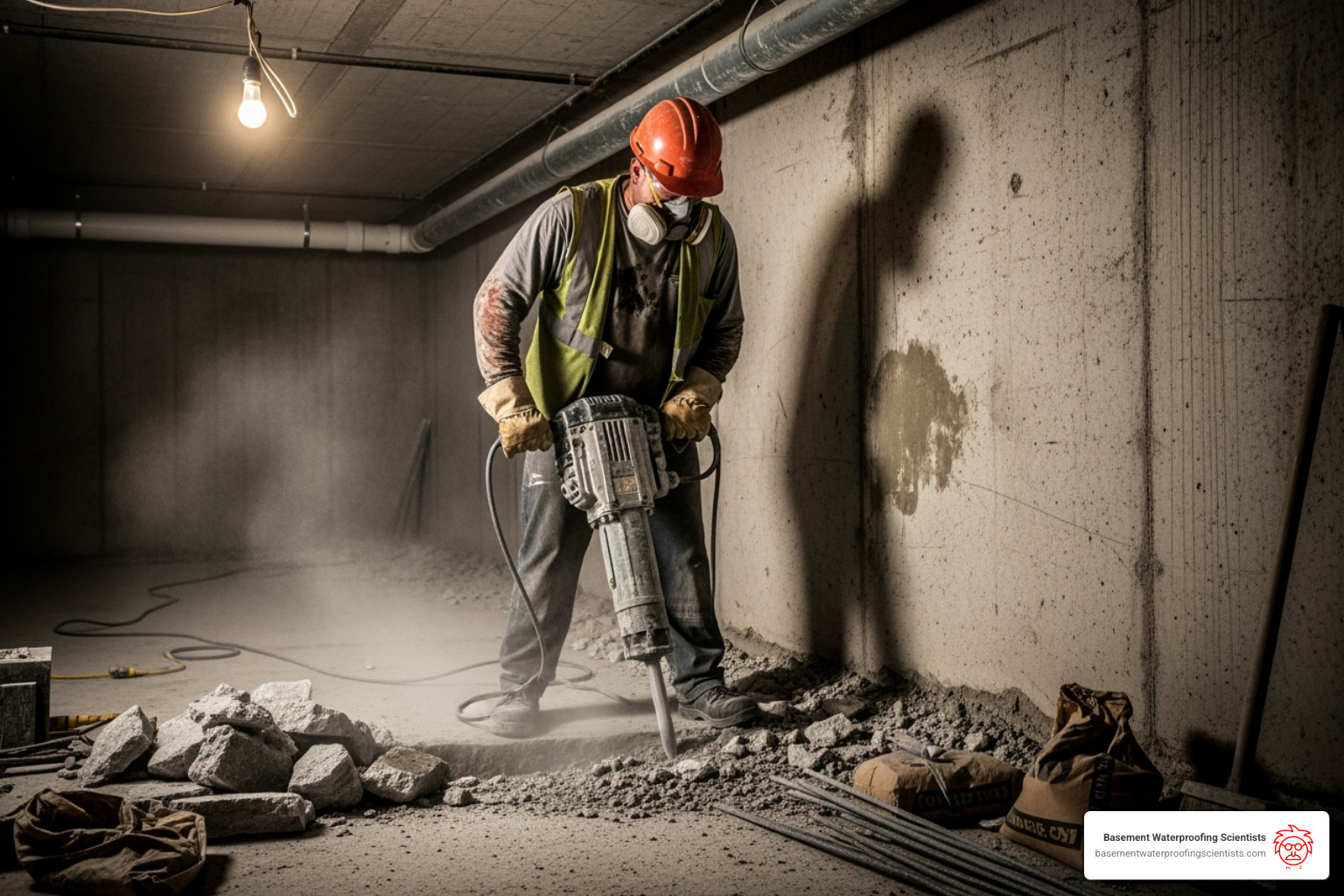
We mark the path for the channel around the basement’s perimeter. Using specialized saws, we cut the concrete slab along the marked lines for a clean trench. We then remove the concrete and soil, excavating a trench about 8-10 inches deep and hauling away all debris. Critically, we create a slight slope in the trench, engineering it so water flows naturally via gravity to the sump pump.
Step 2: Placing the Channel and Sump Basin
With the trench prepared, we install the core components of the system.
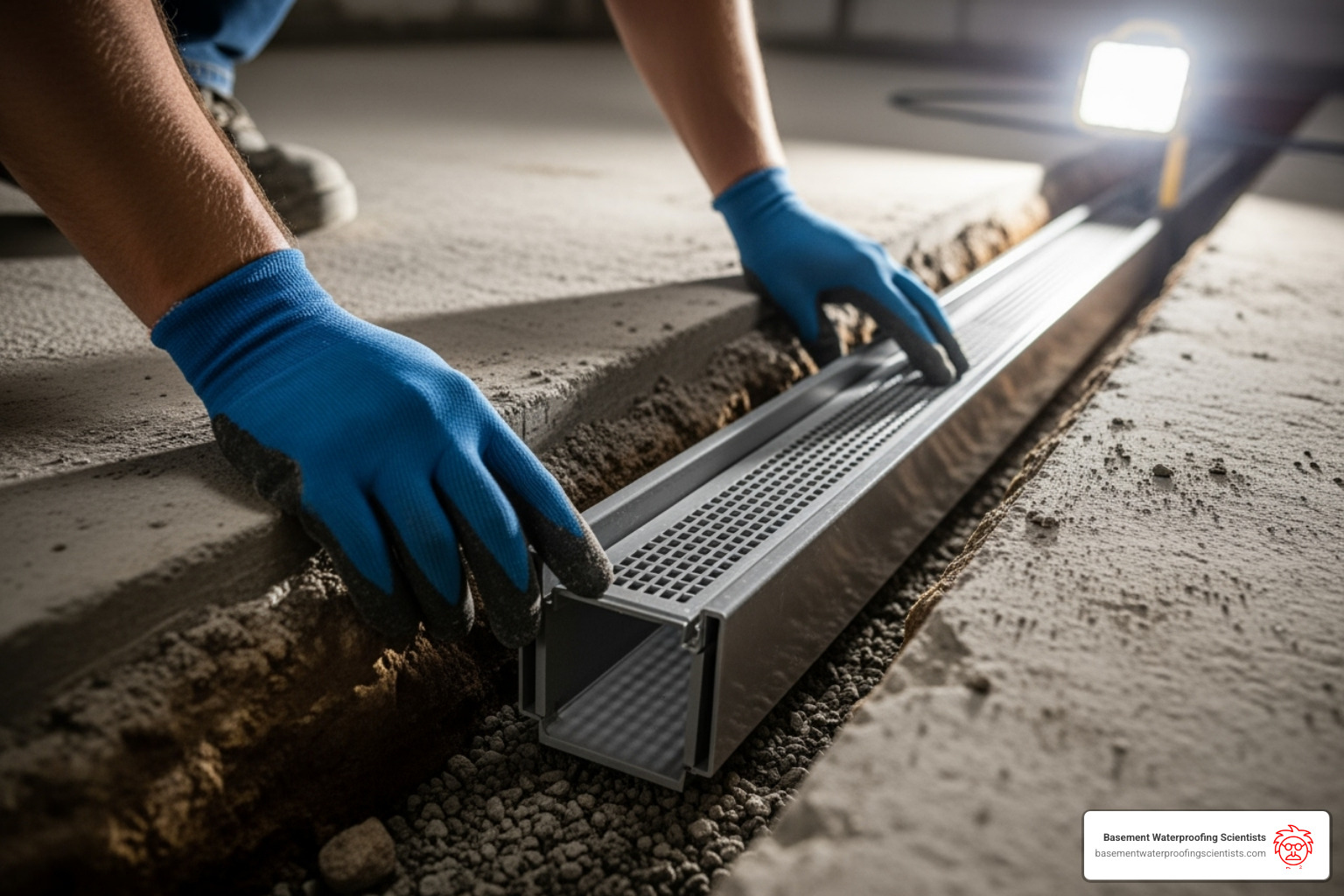
First, we lay a bed of clean drainage stone at the bottom of the trench to create a permeable foundation. Next, we fit the channel sections together, using custom corner pieces to create a continuous, sealed perimeter system. Finally, we connect the channel to the sump pump basin, which is typically placed at the lowest point in the basement. This creates a seamless path for water to exit your home.
Step 3: Backfilling and Restoring the Concrete
This final step restores your floor, leaving behind an invisible, permanent water protection system.
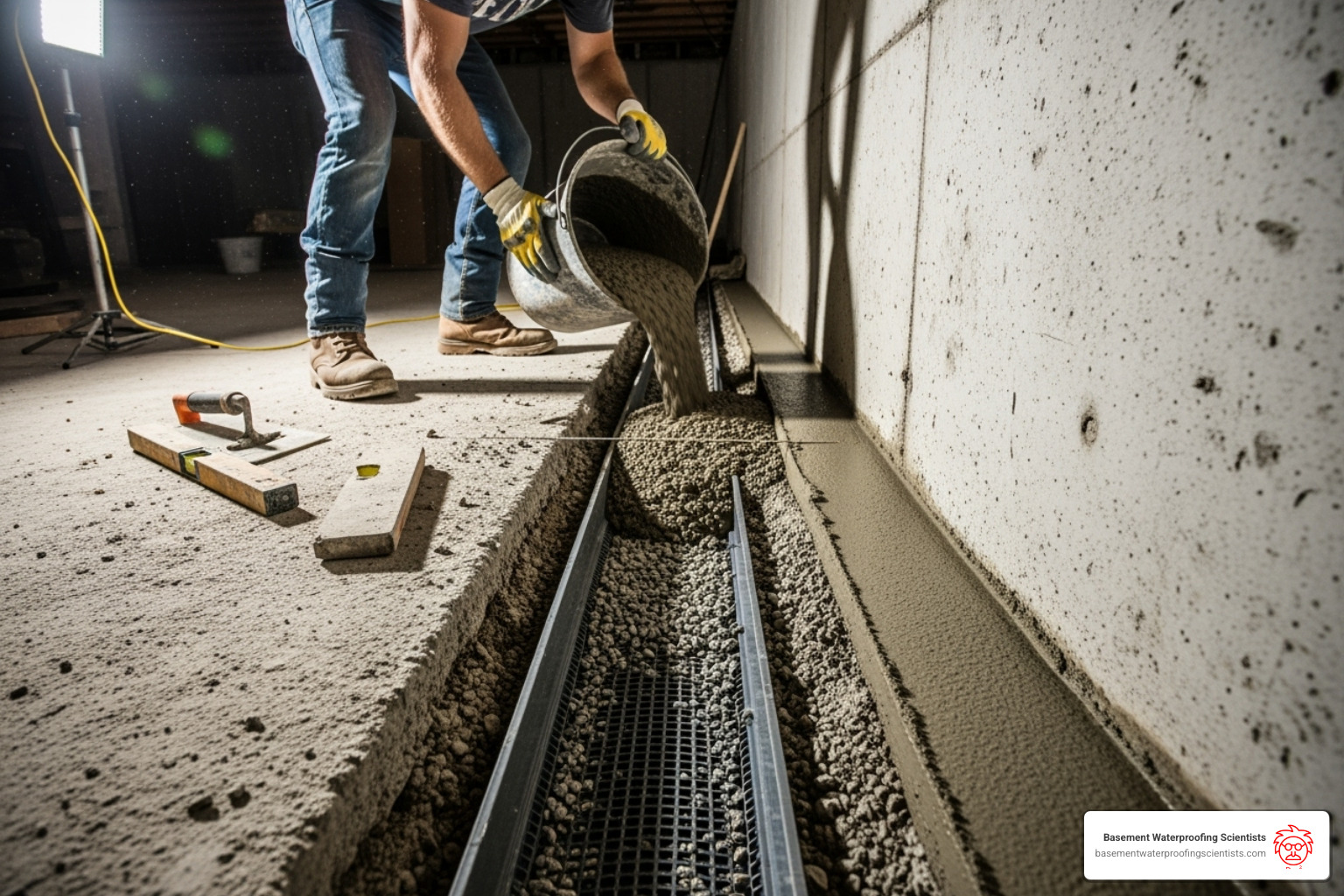
We backfill the trench with more drainage stone, surrounding the channel to filter debris and promote water flow. We then pour high-strength concrete to fill the trench. This special mix bonds with your existing floor, creating a seamless and strong repair. We finish the surface smoothly to match your existing floor, often leaving a small wall flange to allow any wall seepage to enter the system.
“Your team was incredibly neat and professional,” said a customer from Bensalem Township. “The basement water channel solved our water problems, and you can hardly tell it’s there!”
Post-Installation: Maintenance and Long-Term Care
Once your basement water channel is installed, it requires minimal maintenance to ensure its longevity. Our systems are designed to last 20+ years, and a little attention goes a long way.
Maintaining your new basement water channel
Interior channels are designed for easy access and service. We recommend the following simple maintenance tasks:
- Annual Inspection: Check clean-out ports for any visible debris.
- System Flushing: Flush the system every 2-3 years, especially in areas with high mineral content in the water.
- Wall Flange: Use a shop vacuum to clear the wall flange during regular cleaning.
- Sump Pump Test: Regularly test your sump pump by pouring a bucket of water into the pit to ensure it activates.
- Professional Check-up: We recommend a professional inspection every 3-5 years.
Do basement drainage channels always require a sump pump?
Yes, in nearly all cases, a sump pump is essential. The channel collects water, but the pump is what actively removes it from your home. Without it, water would simply pool in the channel and overflow.
Gravity-fed drains are only feasible in rare situations where the basement is significantly above the outside ground grade. For reliable protection, we always recommend a quality sump pump, ideally with a battery backup to ensure it works during power outages.
Frequently Asked Questions about Basement Water Channels
Will installing a basement drainage channel weaken my concrete slab?
No, a properly installed basement water channel will not weaken your concrete slab. The process is designed to maintain structural integrity. We cut only a narrow trench at the perimeter, well away from load-bearing footings. We then restore the floor with high-strength concrete that bonds to the existing slab, creating a repair that is often stronger than the original.
How does an interior channel compare to other waterproofing methods?
Interior channels offer several advantages over other methods:
- vs. Exterior Systems: Interior systems are less disruptive and can be installed year-round. They avoid the extensive excavation that destroys landscaping, patios, and driveways, which is required for exterior systems.
- Cost: Interior systems are typically more cost-effective than exterior solutions.
- Maintenance: Interior channels have accessible clean-out ports for easy maintenance. Buried exterior systems are prone to clogging from roots and silt and are difficult and expensive to service.
- vs. Sealants/Injections: Sealants are temporary, band-aid fixes. They fail as concrete expands and contracts and do not relieve the underlying hydrostatic pressure that causes leaks.
What is the average cost of a basement water channel system?
The average cost for a complete interior basement water channel system is between $4,000 and $8,000. Several factors influence the final price:
- Basement Size: The primary factor is the linear footage of the basement perimeter.
- System Type: The specific type of channel system required for your foundation and water problem affects the cost.
- Sump Pump: The choice of sump pump, especially models with battery backups for added protection, will influence the total investment.
Our pricing is competitive because we use specialized equipment to precisely identify leak sources. This allows for a targeted, effective solution that often costs less than a one-size-fits-all approach. We provide free, no-obligation inspections and detailed estimates to give you a clear understanding of the work and costs involved.
Conclusion
We’ve covered how hydrostatic pressure causes leaks and how a basement water channel provides a permanent solution. You should now feel more equipped to tackle your basement water problems.
An expertly installed basement water channel does more than just move water; it transforms a damp space into a dry, healthy, and usable area. You can reclaim square footage while protecting your home’s structural integrity, improving air quality, and boosting property value. The peace of mind that comes with a dry, safe home is invaluable.
Ready to solve your basement water problems for good? At Basement Waterproofing Scientists, our 30 years of experience and specialized equipment allow us to pinpoint the exact source of your leak. We provide permanent solutions, often for less, backed by a lifetime guarantee. Let’s make your basement dry and usable.

